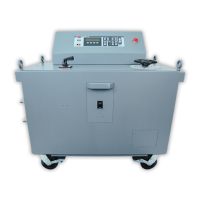I
i .
!
I
~
I i
2. TEST PROCEDURE
FOR
TESTING OF MOLDED CASE AND
LOW
VOLTAGE
POWER CIRCUIT BREAKERS
Always refer to the manufacturer's literature applicable to the particular circuit breaker
before testing. The test operator should be familiar with the operating characteristics
of
the circuit breaker, the tolerances applicable to the operating characteristics and any
means for adjusting the circuit breakers.
Molded case breakers are usually tested for verification
of
the time delay characteristics
and the minimum operating point (pick-up point)
of
the instantaneous element. Low
. voltage power circuit breakers with solid state or electro-mechanical trip devices are
usually tested for verification
of
the time delay characteristics
of
the long time delay and
short time delay elements and for the minimum operating point (pick-up point)
of
the
instantaneous element. Each circuit breaker pole should be tested independently
so
that all trip devices are tested.
One test point is usually sufficient to establish whether the long time delay or short time
delay element is operating properly and within the band width
of
its time-current
characteristics. For molded case breakers the suggested test current
of
the time delay
element is three times (3x) the current rating
of
the breaker;
for
low
voltage power
circuit breakers, suggested test current is three times (3x) the pick-up setting
of
the long
time delay element and one and one half times (1.5x) the short time delay setting where
the type
of
trip characteristics is incorporated on the trip device.
On both molded case and low voltage power breakers, the instantaneous element is
tested to verify the minimum current necessary to cause the breaker to consistently trip
instantaneously.
When testing instantaneous trip elements, run the test below to find the minimum
current required to trip the breaker instantaneously and compare to the setting.
Remember the instantaneous elements have an operating tolerance
of
from
.±
10% to
.±
25%
of
setting, depending on the particular trip device. On molded case circuit
breakers, it is suggested that the time delay elements be tested before any
instantaneous tests are performed.
Most modern low voltage power circuit breakers are
of
the "draw-out" type. These
breakers should be tested using
AVO International Model DDA-3000/6000 equipped
with the appropriate stabs to directly connect the breaker to the test set. When testing
.
molded case breakers
or
any other breaker where leads are required to connect it to
the test set, the leads should be as short as possible and twisted to minimize losses.
See section on Output Leads.
22

